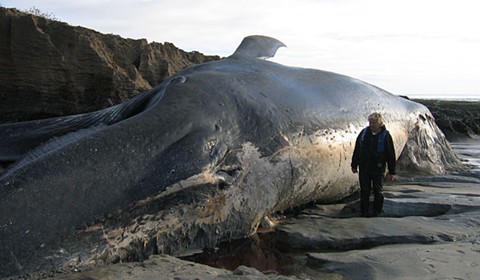
What to do with beached whales who can’t be guided back out to sea, and so perish on the sand? In parts of New Zealand where the indigenous Maori hold sway, this has become quite the conundrum. The trust that oversees Maori fisheries recently proposed harvesting such unfortunate cetaceans for meat—arguably a more humane option than traditional whaling, though perhaps lacking a certain ceremonial oomph. But that suggestion may conflict with a Maori custom that calls for dead whales to be treated with reverence due deceased humans, a policy that would seem to forbid the lopping off of blubber post-mortem.
But is the Maori insistence on proper burials posing a threat to beachgoers’ health?:
Whales buried beneath New Zealand beaches could be releasing harmful toxins into the sand, a new study has concluded.
A 2009 thesis by AUT masters student Ann Bui studied the chemical effects of whale burial at Pakiri beach and Muriwai beach over six months in 2008.
Oceanographer Steve O’Shea, who was overseeing the project, said initial results show “massive spikes” in E coli bacteria 18 months after burial. He also suspected graves could house listeria bacteria.
“We’ve got 8000 whales buried under our beaches,” he said. “Is there a ticking time bomb beneath the sand?”
It’s also worth noting that during last month’s mass beaching, guards were posted in order to prevent local fishermen from removing the whales’ teeth—presumably because they wished to manufacture some of these powerful talismans.


captured shadow // Jan 19, 2010 at 4:40 pm
Finding E.Coli around dead whales is not exactly unexpected. You’d have to get down and lick the sand to get infected though. Too bad the Maori can eat the dead whales, seems like a lot of tasty meat going to waste to me.
Steve O'Shea // Jan 21, 2010 at 7:54 pm
I can assure you that E. coli is the very least of our concerns; there’s some real bad stuff in there; it is ongoing work, but I’m sure if you are interested that you’ll hear of it.
The reason for burial is not because of maori insistence; burial is commonplace worldwide, and probably the most economic solution to the problem of ‘what to do’ with a large carcass. The problem with burial is that the gravesites are unmarked, and massive spikes in bacteria persist in the sands to some depth (4 metres) for at least 18 months (this is the latest data we have). Given ~ 8000 whales have been buried in our beaches since 1978 alone, that’s a lot of potential beach contamination, and a lot of these bacteria can cause very serious health issues. Thus, our major concern is the health and safety implications of this practice; at the very lease the grave sites should be marked. The danger is, of course, that people then will dig the carcasses up to recover teeth or bone; both are important to maori.
I just wanted to clarify a few matters; I trust you don’t mind.
Steve
Buried Whales, Cont’d // Jan 22, 2010 at 8:49 am
[…] recent post about the hazards of whale burial attracted a celebrity commenter: Steve O’Shea of the Auckland University of Technology. Best […]
Brendan I. Koerner // Jan 22, 2010 at 8:53 am
@Steve O’Shea: Thanks a million for the sage insight. I’ve bumped up your comment to the front page.
I will certainly keep an eye peeled for the final paper regarding your team’s research.
Steve O'Shea // Jan 22, 2010 at 3:55 pm
No worries Brendan … but celeb not.
We were rather concerned about the earlier report going out when we weren’t finished with our analyses, hence its brevity (we were contacted by the reporter, but we just had to shut up). The poor chap didn’t get the scoop he wanted.